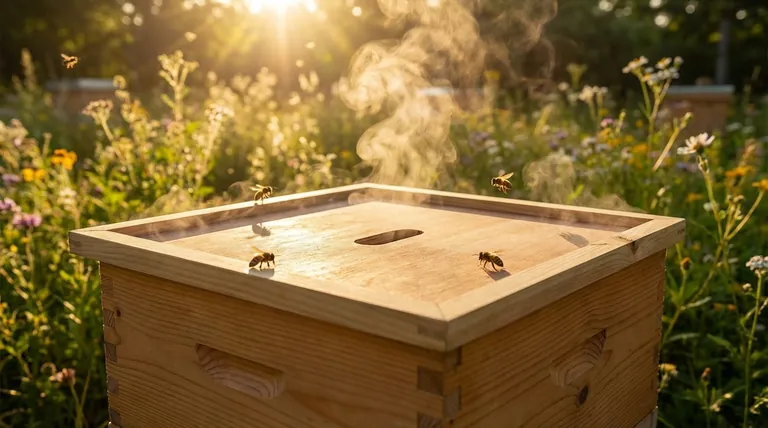In short, wooden beehives regulate temperature through two key properties: natural insulation and superior breathability. The cellular structure of wood slows the transfer of heat, protecting the colony from extreme external temperatures. Simultaneously, its ability to breathe allows excess moisture from the bees' respiration to escape, preventing dangerous condensation and promoting a stable, healthy internal environment.
A beehive is not just a box; it's an active environmental system. While bees themselves perform the work of thermoregulation, a wooden hive acts as a crucial partner, moderating the environment so the colony can dedicate less energy to survival and more to growth and honey production.

The Science of Hive Thermoregulation
A honeybee colony works tirelessly to maintain a stable internal temperature, aiming for around 95°F (35°C) in the brood area. The hive material plays a significant role in how much energy they must expend to achieve this.
The Role of Natural Insulation
Wood is a natural insulator because its structure is filled with microscopic air pockets. These pockets disrupt the transfer of heat.
In the winter, this means the precious warmth generated by the bees' shivering "winter cluster" is retained more effectively. Less heat escapes through the hive walls.
In the summer, the same principle works in reverse. The wood's insulation slows the penetration of intense solar heat, helping the bees keep the hive cool with less effort spent fanning their wings.
The Critical Importance of Breathability
Breathability refers to a material's ability to allow water vapor to pass through it. This is arguably more important than insulation alone.
A colony generates a tremendous amount of moisture through respiration and the process of curing nectar into honey. A 20,000-bee colony can release over a cup of water into the air each day.
If this water vapor cannot escape, it creates a damp, unhealthy environment.
How Wood Manages Internal Moisture
Wooden hives excel at managing this moisture. The wood fibers can absorb excess water vapor from the air when humidity is high and release it when the air is drier.
This property acts as a natural buffer, effectively dehumidifying the hive and preventing the most significant danger: condensation.
Common Pitfalls to Avoid
Choosing a hive material involves understanding its physical properties and the consequences for the colony. The most common mistake is focusing solely on insulation value while ignoring moisture management.
The Problem with Trapped Moisture
Non-breathable materials, such as plastic or styrofoam hives, can trap this water vapor.
In cold weather, the warm, moist air rises and hits the cold inner surface of the hive top, causing condensation. This water then drips back down onto the bees, chilling them and potentially killing the colony.
This damp environment is also the perfect breeding ground for mold, mildew, and pathogens like Nosema, a serious bee disease.
Insulation vs. Breathability
While a synthetic hive may have a higher R-value (a measure of insulation), its lack of breathability creates a new problem that must be solved with artificial ventilation.
Wood offers a holistic solution: good insulation combined with excellent natural breathability. It manages both temperature and humidity, creating a system that works with the bees' natural behaviors, not against them.
Making the Right Choice for Your Colony's Health
Your choice of hive material directly impacts your bees' well-being and the amount of intervention required from you as a beekeeper.
- If your primary focus is creating a stable, low-stress environment: Choose wood. Its combination of insulation and breathability provides the most forgiving and naturally regulated home for your bees.
- If your primary focus is durability and low cost: Synthetics are an option, but you must be prepared to actively manage ventilation to combat the inevitable moisture buildup and prevent disease.
Ultimately, selecting the right material is about supporting the colony's incredible ability to manage its own home.
Summary Table:
| Feature | Benefit for Bees | Why It Matters |
|---|---|---|
| Natural Insulation | Slows heat transfer, protecting from extreme external temperatures. | Reduces energy bees spend on heating/cooling, promoting growth. |
| Superior Breathability | Allows excess moisture to escape, preventing dangerous condensation. | Mitigates risk of mold, mildew, and diseases like Nosema. |
| Moisture Buffering | Wood absorbs and releases water vapor, acting as a natural dehumidifier. | Creates a stable, healthy internal environment with less keeper intervention. |
Equip your apiary with the natural advantage of wooden beehives. At HONESTBEE, we supply high-quality, durable beekeeping equipment designed to support colony health and productivity. Our wholesale-focused operations provide commercial apiaries and distributors with reliable supplies that work in harmony with nature. Ready to enhance your beekeeping success? Contact our team today to discuss your needs and discover the HONESTBEE difference.
Visual Guide

Related Products
- Inner Beehive Cover for Beekeeping Bee Hive Inner Cover
- Professional Insulated Winter Hive Wrap for Beekeeping
- Professional Galvanized Hive Strap with Secure Locking Buckle for Beekeeping
- Professional Grade Foldable Beehive Handles
- Black Plastic Beetle Barn Hive Beetle Trap for Beehives
People Also Ask
- How is the inner cover used to promote ventilation? Master Hive Climate Control for Healthy Bees
- What is an inner cover in a beehive and what are its features? A Key Tool for Hive Health & Management
- What is the role of the inner cover in a beehive? Essential Climate Control for Hive Health
- What is the recommended orientation for the rim of an inner cover? Master Hive Ventilation and Insulation
- What is the function of an inner cover in a beehive? Essential for Hive Health & Management



















